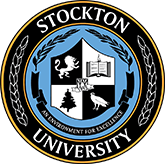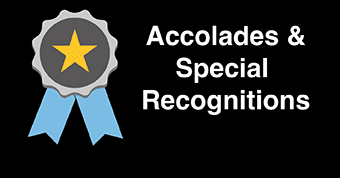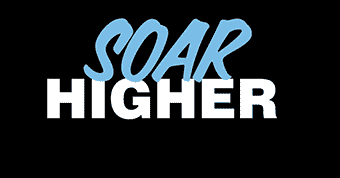Fire Safety and Prevention
Under the authority of the State of New Jersey, Division of Fire Safety, The Stockton University Department of Public Safety. Fire Safety and Prevention personnel are responsible communicating to all University units the requirement that will assure University compliance with the New Jersey Uniform Fire Code.
The State of New Jersey, Division of Fire Safety routinely sends fire inspectors who regularly inspect all University premises to assure compliance with fire safety regulations, and to issue Notices of Violations when compliance is not met.
For more information on any of the following subjects please contact our Fire Safety & Prevention Officer, at
firesafety@stockton.edu or call 609-626-6127
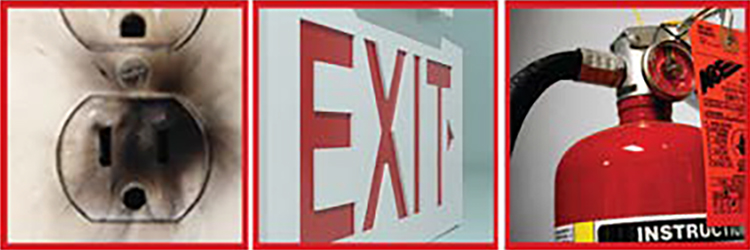
- The Fire Safety Division is empowered, by New Jersey Regulation, to order the abatement of cited fire hazards, to assess penalties for non-compliance, and to issue punitive closing notices and vacate buildings where uncorrected hazards exist.
- Fire safety inspections generate formal, written Notices of Violation, which are issued to the individual responsible for the correction of an observed fire hazard.
- Re-inspections are established and are conducted.
- There is a process that is followed for granting extensions of time for hazard abatement, as well as handling uncorrected cited hazards.
- All fire protection systems are inspected at the frequencies required by the Uniform Fire Code.
- These include automatic sprinkler systems, standpipe systems, fixed suppression systems, fire alarm systems, emergency power generators, fire pumps, fire extinguishers and fire hydrants.
- In order to maintain a safe and prepared living environment for all residents the Office of Residential Life in collaboration with the Office of Risk Management will conduct two sets of unannounced fire drills each semester of each residential complex.
- One set will be during the daytime and another set will be at night time with one of the drills occurring within the first 10 days of the semester.
- Upon hearing a bell/horn/buzzer alarm and/or seeing a visual blinking (strobe light) signal device activated and/or as directed by the Stockton Police, all persons shall assume that an emergency is in effect and immediately evacuate the building in an orderly manner.
- All persons should exit through the nearest outer door of each building, away from the activated fire alarm devices, and assemble in areas not less than 300 feet from the buildings, staying clear of all road ways and emergency response vehicles and personnel.
- In the event a particular exit is blocked, the next available exit should be used.
- Elevators are not to be operated during an evacuation.
- Failure to evacuate is a violation of New Jersey statute and violators are subject to penalties prescribed by law. Police and fire officials are to be notified of anyone remaining in the building.
- Once outside, stay away from the building and congregate with people from your class/building groups in the identified areas.
- Try to account for all people after gathering at the assembly point to ensure that they have evacuated safely.
- If you suspect there are still people in the building, immediately notify University Police or Emergency Personnel.
- It is vital that you congregate to these areas for both the accountability of everyone, as well as the safety of the evacuees to stay a safe distance from the building to avoid any heat or smoke contact, as well as building construction failure safety.
- Likewise, these areas are identified to keep everyone out of harms way of traffic for the emergency services apparatus that will be responding with efficiency and purpose.
- The signal to return to the buildings shall be given by Campus Police or Fire Department personnel. No one is to re-enter an area until an all-clear signal has been given by one of the above uniformed personnel.
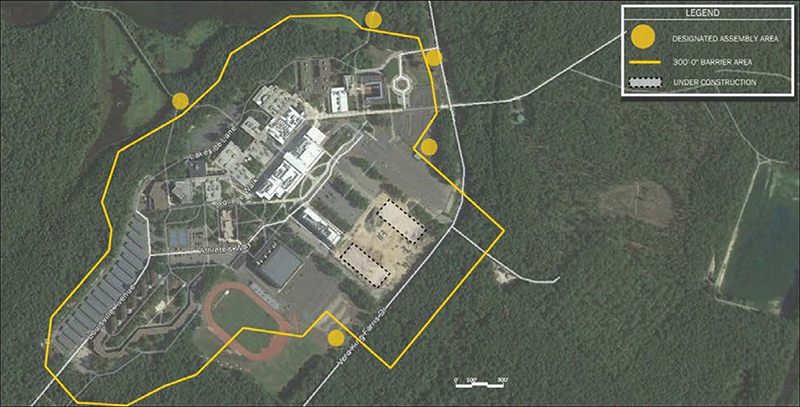
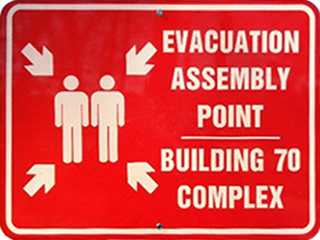 example of evacuation assembly point sign
example of evacuation assembly point sign
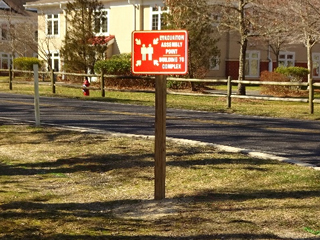 evacuation assembly point installed sign post
evacuation assembly point installed sign post
- Housing 1: A & B - Located in path around Lake Fred just past Laurel Lane
- Housing 1: C thru F - located in beach section between Lodge at Lakeside and Oasis Beach
- Housing 1: G & H - located in Heather/Greenbriar parking lot
- Housing 2: A thru F - located by the tennis courts outside of parking lot 6
- Housing 2: G thru K - located in the North end of parking lot 7
- Housing 3 - located by the tennis courts outside of parking lot 6
- Housing 4 - located in the North end of the North parking lot
- Housing 5: I thru K - in the grass between the volleyball court and the South lot
- Housing 5: L thru N - located in Northeast section of the West lot
- Chris Gaupp - Sidewalk Across from Building by Flagpoles
- A.C. Residential Buildings A and D - Boardwalk and Hartford Ave.
- A.C. Residential Buildings B and C - Boardwalk and Lincoln Pl.
Evacuation Stair Chairs are located in the following places:
- Arts & Science Building 2nd floor
- Multi-Purpose Rec Center (Big Blue) 3rd floor
- West Quad 2nd floor
- Campus Center 2nd floor
Fire Alarm Pull Station
Fire Alarm Device
- Most buildings are protected by automatic sprinkler systems and others are provided with fire standpipe systems.
- All major buildings are equipped with automatic fire detection and alarm systems, which are constantly monitored at the respective University Police Department Dispatch stations.
- Special hazards, such as chemical storage, high voltage electrical, cooking, spray painting and computer installations are protected by fixed suppression systems in addition to the aforementioned types of built-in protection.
- There are no fire hoses for building occupant use located in any University building; only fire hose connections for fire department use exist.
University buildings are equipped with fire extinguishers in accordance with the requirements of the construction and/or fire safety codes. Students and employees are not expected to utilize these devices, nor are they trained in their use due to the danger of their personal safety, which would result from attempting to extinguish a fire.
Extinguisher Locations
Extinguishers are kept in the following locations on campus:
- Fire Extinguisher Cabinets - smaller, less-conspicuous cabinets usually located in exit corridors and recessed into the walls. This is a common extenguisher location in newer buildings.
- Wall-mounted Brackets hold extinguishers that are not stored in cabinets. This method keeps extinguishers in plain view on the walls, and is most common lin laboratory work areas, workshops, and large office suites.
Extinguishers Inspection Stickers
Fire Prevention Services personnel attach paper tags to extinguishers that are hole-punched
to indicate the month and year of the last mainenance inspection
Fire Permit applications must be submitted at least 5 business days prior to an event or activity.
NOTICE: Fire Permit applications are currently not being accepted for Bon Fires
fill out a Fire Permit Application
For Religious & Special Events ONLY
fill out a Candle Waiver Application
ITEMS AND ACTIONS NOT PERMITTED
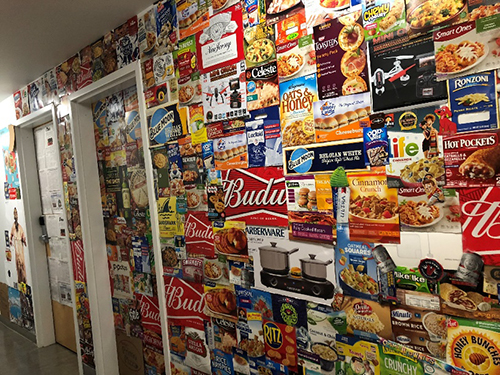 Bed or furniture reducing the required width of the exit
Bed or furniture reducing the required width of the exit- Items hanging from the sprinkler head or pipe, heat detector, smoke detector or alarm
- Unattended cooking, burning candle, or other open flame
- Presence of candles of any type or form, oil lamp, or incense
- Tampering with building fire alarm system
- Discharge of Fire Extinguisher
- Failure to evacuate building during an actual fire alarm or evacation drill
- Execessive quantity of combustible materials on walls or ceilings. Posters, fish nets or tapestry
- Electrical cords (extension cords) are for temporary use only and are not permitted to be used as a substitute for permanent wiring. Electrical appliances must be plugged directly into an electrical outlet or an approved and listed surge protector.
- Space heaters
The followng appliances are prohibited in all dormitory rooms; and in the bedrooms, bathrooms and living rooms of apartments:
- Electric toaster ovens
- Broilers
- Skillets
- Hotdog/hamburger cookers
- Electric woks
- Rice cookers
- Microwave ovens not provided by the University
From the Guide to Residential Life
- Furniture Elevation Devices prohibited (Rack Risers)
- No additional microwaves or refrigerators
- Cooking and food warming devices and portable heat producing items with internal heating
elements are prohibited
- (Coffee Makers are okay)
- MICROWAVES: Must not exceed UL listed regulation 120 volts 68Hz and 1.1 kilowatts
- Only one microwave permitted in each apartment
- NO patching or painting
- Do not refinish the furniture
- Do not paint or paper the room
- Do not install or use wood paneling and/or tiles of any composition
- Do not use nails, screws, or adhesive substances such as contact paper, glue, double sided tape, or decals on walls, ceilings, floors, doors, or furnishings
- Do not remove curtains/drapery from window
- Do not remove screens from any windows
- Do not remove furniture from apartments or bedrooms
- Combustibles such as straw, hay, palm fronds, vines, branches, ect. are prohibited
- Large combustible wall coverings such as, but not limited to, curtains, decorative lighting (plug-in and battery-operated string lights, holiday lights, lava lamps), posters, tapestries, flags, construction paper, excessive party decorations, ect. are prohibited
- All string lighting is prohibited in the residential areas. Lava lamps, halogen lights, heat lamps, neon and black lights are not permitted in any residential areas
- Candles and Incense, lit or unit, are strictly prohibited in all residential areas. Anyone having candles or incense, or activating the smoke alarm system with a candle or incense is subject to a fine. Second offenses will result in housing probation. If a candle with a burnt wick is found during a fire inspection, it will be reported to the Complex Director who may remove the candle at their discretion.
- Wax warmers, fragrence plugins or wickless candles are not permitted
- The State Fire Marshall prohibits the use of any live trees within residential areas owned and/or leased by the State of New Jersey. Artificial holiday trees found within residential areas must have certification indicating that they are fire resistant and/or flame proof.
- Extension Cords and multi plug outlet adapters are prohibited in all residential facilities. Only ULapproved circuit of fuse protected power strips are permitted.
- Devices with external heating plates are prohibited in all residential life areas. This may include but is not limited to, coffee makers and coffee pots, hot plates, ect. However, coffee makers with internal heating elements such as Keurig coffee makers are acceptable as long as the heating element is internal
- All fireworks and incendiary devices are illegal in the State of New Jersey and prohibited on campus.
- Hookahs, e-cigarettes, vapors, shishas or similar pipes are only permitted in designated smoke areas and are subject to the University’s and State of New Jersey’s smoking laws and policies
- Attaching objects to any window ledges, roofs or other exteriors of buildings
- Residents much never be present on any building ledge or roof
- Use of trampolines in the residence facilities or on campus is prohibited
- Use of Residential Life’s fire place without authorization from a representative of Residential Life and/or a fire permit
- No person shall be in possession of tattooing kits or paraphernalia. Any person found in possession of any type of tattooing kits or paraphernalia may be subject to disciplinary action
- All students are prohibited from the use of Unmanned Aircraft System, also known as drones in and around any residential life area in order to provide a safe environment for students. Any university employee, or student planning to operate an UAS as part of their University employment or used in support of research, teaching, or testing as part of a University program near any residential life area must fire contact the Director for Residential Life or their designee for approval
- Waterbeds, water furniture, hot tubs, spas, and jacuzzis are prohibited in all areas inside, outside, and immediately adjacent to the residential complexes
- No person shall feed any unconfined wildlife located on University property, except when such wildlife is part if approved academic research. Feeding does not include baiting when performed by persons fishing with licenses. No hunting of any kind if permitted on campus. Feeding occurs when one gives, places, exposes, deposits, distributes, or scatters a material with the intention of feeding, attracting, or enticing wildlife.
